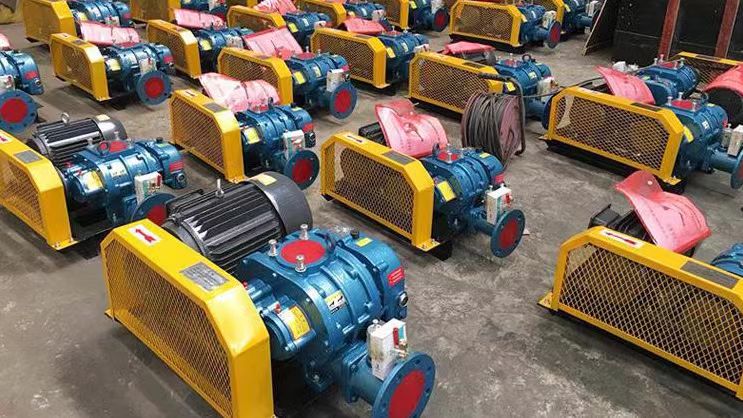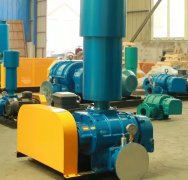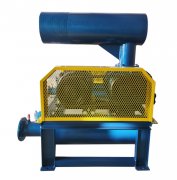**Guidelines for Temperature Management of Roots Blowers: Normal Range, Abnormal Causes, and Handling Measures**
The temperature of Roots blower is a key indicator reflecting its operating status, and abnormal temperature may indicate faults or system problems. The following is an analysis of the temperature of the Roots blower:
---

**1、 Normal temperature range for each part**
|* * Location * * | * * Normal temperature range * * | * * Critical alarm temperature * * | * * Measurement method * *|
|------------------|----------------------|----------------|--------------------------|
|* * Bearing * * | ≤ 70 ℃ | ≥ 85 ℃ | Infrared thermometer or surface mount sensor|
|Gearbox oil temperature * * | 40 ℃~80 ℃ | ≥ 90 ℃ | Oil temperature gauge or built-in probe|
|Exhaust gas temperature * * | ≤ 100 ℃ (normal operating conditions) | ≥ 120 ℃ | Pipeline temperature sensor|
|* * Motor casing * * | ≤ 80 ℃ | ≥ 95 ℃ | Hand feel or thermometer|
---
**2、 Common causes and solutions for high temperature**
**1. Bearing overheating**
-Possible reasons:
-Insufficient lubrication or deterioration of grease (check if the grease color turns black).
-Bearing wear or improper installation (listen for any abnormal noise).
-The belt is too tight (the tension needs to be adjusted to a depth of 10-15mm when pressed by hand).
-* * Solution * *:
-Add or replace lubricating grease (using high-temperature lithium based grease).
-Replace bearings (recommended to replace in pairs).
**2. High gearbox oil temperature**
-Possible reasons:
-Insufficient oil quantity or aging oil quality (cloudy oil or metal shavings).
-Poor gear meshing (check for signs of gear wear).
-Insufficient cooling (high ambient temperature or blocked heat sink).
-* * Solution * *:
-Change the oil and clean the oil tank (recommended ISO VG320 synthetic gear oil).
-Install a cooling fan or water cooling jacket (for high temperature environments).
**3. Abnormal exhaust temperature**
-Possible reasons:
-Excessive system resistance (check if the pipeline valves are fully open).
-High intake temperature (if inhaling hot air, a cooler needs to be installed).
-Internal leakage (gas backflow caused by rotor or wall wear).
-* * Solution * *:
-Clean the pipeline filter or increase the pipe diameter.
-Repair the sealing gap (standard rotor gap 0.1~0.3mm).
**4. Motor overheating**
-Possible reasons:
-Voltage instability (three-phase imbalance>5).
-Overload operation (current exceeding rated value).
-Cooling fan malfunction (check if the fan rotates normally).
-* * Solution * *:
-Install a voltage regulator or adjust the load.
-Clean the dust from the ventilation holes of the motor.
---
**3、 Recommended cooling measures**
1. Passive heat dissipation**
-Clean the dust on the fan casing (especially the heat dissipation fins).
-Ensure ventilation in the installation environment (spacing ≥ 1m).
2. * * Active cooling**
-* * Air cooling * *: Install an axial flow fan (suitable for small Roots blowers).
-Water cooling: Install a circulating water cooling jacket on the gearbox or exhaust pipe (for high temperature conditions).
3. * * System optimization**
-Reduce compression ratio (adjust bypass valve or reduce system back pressure).
-Variable frequency control (to avoid prolonged full load operation).
---
**4、 Temperature monitoring and maintenance recommendations**
1. * * Daily monitoring**
-Record the temperature of bearings and gearboxes for each shift (it is recommended to use a digital thermometer).
-Compare historical data and promptly investigate trends that have increased.
2. * * Regular maintenance**
-* * Monthly * *: Check the lubrication system and clean the heat dissipation components.
-* * Annual * *: Thermal imaging scans to detect potential hotspots.
3. * * Alarm settings**
-Install temperature switches (such as normally closed contacts at 80 ℃) and interlock shutdown protection.
---
**5、 Special working condition temperature management**
|* * Working conditions * * | * * Risks * * | * * Response measures * *|
|-------------------|------------------------|--------------------------------|
|* * High temperature environment * * | Decreased heat dissipation efficiency | Choose high-temperature resistant oil (synthetic oil) and shorten the oil change cycle|
|* * High dust * * | Blocked heat sink | Install dust screen and clean weekly|
|* * High humidity * * | Emulsification of lubricating oil | Use waterproof grease (polyurethane) and install oil-water separator|
---
**Summary**
The abnormal temperature of Roots blowers is often a comprehensive result of poor lubrication, excessive load, or insufficient heat dissipation.
-* * Key mnemonic * *:
-Bearing 70 should not exceed the standard, and gear 90 should sound an alarm.
-Lubrication and cleaning are fundamental, and optimizing heat dissipation is essential.
It is recommended to integrate * * temperature automatic alarm function * * into the fan control system and save complete operation logs for fault tracing. For persistent high temperature issues, it is necessary to contact the manufacturer for systematic diagnosis.



